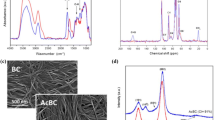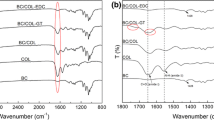Abstract
Bacterial cellulose/poly(vinyl alcohol) (BC/PVA) composite membranes using BC as the reinforcement and PVA as the matrix material were prepared in supersaturation of sodium chloride and crosslinked with glutaraldehyde, and characterized by attenuated total reflection Fourier-transform infrared spectroscopy, equilibrium swelling ratio tests, and mechanical properties tests. The chemical crosslinking degree of the membranes was determined by titration method, and it could be controlled by crosslinking time. The effects of the chemical crosslinking degree on properties of the BC/PVA composite membranes were investigated. It was demonstrated that chemical crosslinking was formed between BC/PVA and glutaraldehyde. As a result, the chemically crosslinked BC/PVA composite membranes exhibited some promising characteristics, such as appropriate equilibrium swelling ratio, good mechanical strength, and obvious effect of chemical crosslinking degree. Furthermore, the equilibrium swelling ratio and mechanical properties of the BC/PVA composite membranes were obviously affected by the BC content as well.
Graphical Abstract




Similar content being viewed by others
References
Shoda M, Sugano Y (2005) Biotechnol Bioprocess Eng 10:1
Jonas R, Farah LF (1998) Polym Degrad Stab 59:101
Shah J, Brown RMJ (2005) Appl Microbiol Biotechnol 66:352
Yano H, Sugiyama J, Nakagaito AN, Nogi M, Matsuura T, Hikita M, Handa K (2005) Adv Mater 117:153
Czaja WK, Young DJ, Kawecki M, Brown RM (2007) Biomacromolecules 8:1
Klemm D, Schumann D, Kramer F, Hessler N, Hornung M, Schmauder HP, Marsch S (2006) Adv Polym Sci 205:49
Svensson A, Nicklasson E, Harrah T, Panilaitis B, Kaplan DL, Brittberg M, Gatenholm P (2005) Biomaterials 26:419
Lee KY, Blaker JJ, Bismarck A (2009) Compos Sci Technol 69:2724
Nge TT, Nogi M, Yano H, Sugiyama J (2010) Cellulose 17:349
Paradossi G, Cavalieri F, Chiessi E, Spagnoli C, Cowman MK (2003) J Mater Sci Mater Med 14:687
Hassan CM, Peppas NA (2000) Adv Polym Sci 153:37
Cascone MG, Laus M, Ricci D, Sbarbati Del Guerra R (1995) J Mater Sci Mater Med 6:71
Kelly CM, Demerlis CC, Schoneker DR, Borzelleca JF (2003) Food Chem Toxicol 41:719
Lee JA, Kim MN (2003) Polym Degrad Stab 81:303
Eichhorn SJ, Baillie CA, Zafeiropoulos N, Mwaikambo LY, Ansell MP, Dufresne A, Entwistle KM, Herrera-Franco PJ, Escamilla GC, Groom L, Hughes M, Hill C, Rials TG, Wild PM (2001) J Mater Sci 36:2107
Guhados G, Wan W, Hutter JL (2005) Langmuir 21:6642
Wang JH, Gao C, Zhang YS, Wan YZ (2010) Mater Sci Eng C 30:214
Millon LE, Wan WK (2006) J Biomed Mater Res Part B 79:245
Millon LE, Oates CJ, Wan WK (2009) J Biomed Mater Res Part B 90:922
George J, Ramama KV, Bawa AS, Siddaramaiah (2011) Int J Biol Macromol 48:50
Kim KJ, Lee SB, Han NW (1993) Polym J 25:1295
Acknowledgments
Authors recognize financial support by the Fundamental Research Funds for the Central Universities (Code: 12D10548).
Author information
Authors and Affiliations
Corresponding author
Rights and permissions
About this article
Cite this article
Yang, L., Yang, Q. & Lu, Dn. Effect of chemical crosslinking degree on mechanical properties of bacterial cellulose/poly(vinyl alcohol) composite membranes. Monatsh Chem 145, 91–95 (2014). https://doi.org/10.1007/s00706-013-0968-9
Received:
Accepted:
Published:
Issue Date:
DOI: https://doi.org/10.1007/s00706-013-0968-9




